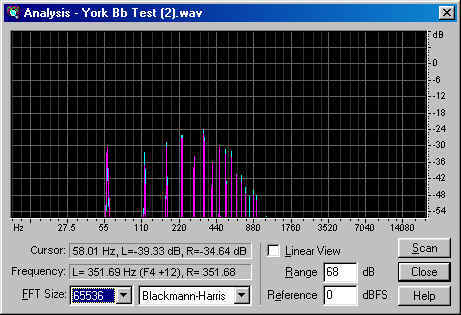Well, yes, but you can't exactly extrapolate what you've done with your system to any common user experience.
The whole point is to do things on purpose, so that we tailor the sound to what we want, not have it tailored for us without our knowing. You've found a way to do things on purpose, but that doesn't translate to most of the people who buy stuff to be cool at the next audio club meeting, or to spout off adjectives to make themselves look like one of the cool kids on A'gon.
Here is the spectrum of me playing a 58-Hz low Bb on a tuba:
(Yes, it was a long time ago when I did this.)
Note the harmonics. The strongest components, even stronger than the fundamental, are the fourth and sixth overtones. These are what gives the tuba (at least as played by a moron like me) its characteristic sound.
Now, let's add some second-harmonic distortion. (I haven't done this actually--this is a thought experiment.) I would expect to see a stronger set of even-order harmonics--the 116-Hz harmonic would be stronger, and its second harmonic, the 232-Hz harmonic, would also be stronger, etc.
Okay, if we were to record a euphonium (bugle is half the length of the tuba measured above, and therefore nominally pitched an octave higher, but very much the same bugle shape and tonal profile, being really a tenor tuba instead of a contrabass tuba) playing a 58-Hz Bb, we would get a lower fundamental and higher harmonics. This is because a 58-Hz Bb is a "pedal" tone on the euphonium, while an octave above the pedal on a contrabass tuba, and pedals are harder to play with a full and stable tone. And the euphonium player would have to play louder to achieve the same level, because the euphonium is half the linear dimensionless ratios compared to the contrabass tuba, and simply doesn't propagate as much vibrating air. But playing louder adds to the upper harmonics in a way that signals "louder" more clearly than the difference in SPL. Louder is as much about timbre as SPL for brass players.
My point is that a recorded contrabass tuba, played back on a system with perceptible even-order harmonic distortion, sounds more like a euphonium.
Dammit, I want a contrabass tuba to sound like a contrabass tuba. I want a French horn to sound like a French horn, and not a trombone. I want a trombone to sound like a trombone, and not a trumpet. I don't want any confusion between a standard trumpet and a piccolo trumpet.
I play in a brass quintet routinely, and have done so professionally (well, that's an overstatement--let's say I've been occasionally paid). I know what these instruments sound like in real life. I want to listen to the Boston Brass, or the Empire Brass, or the Canadian Brass, and hear the differences in those players. (I've played on the same stage with two of those groups and know what they sound like in real life, too, including the difference in sound between Sam Pilafian, Boston and Empire--RIP--and Chuck Daellenbach, Canadian Brass, despite that both used similar instruments.) Systems that seek to enhance my listening experience without my permission take me one further step away from what it was like to be in the presence of their sound. My mind can account for the difference in room effects, but timbre is
important.
Now, I'll bet that hundreds of thousands of people (since that seems to be the number that validates a notion) don't have any idea what a tuba is supposed to sound like (my teachers might include me in that category), and they might like it better if it sounds more like a euphonium. Frankly, I don't care. But the desire for live orchestras to sound like reproduced classical music has led to orchestras trying to play louder and louder, with more and more focus on technical perfection, and bigger tone to be louder without the timbral effect that listeners interpret as "louder". And this has not been good for music or for performers. That is, however, a significant digression.
Rick "who doesn't much care about the female lounge singers most reviewers seem to think must be enhanced" Denney
